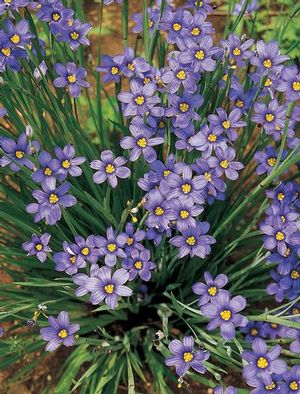New Moon Nurseries
Sisyrinchium angustifolium 'Lucerne'
Blue-eyed grass
Native to North America (cultivar)
FIRST IMPRESSIONS: Sisyrinchium angustifolium ‘Lucerne’ is a low rhizomatous wildflower. Plants form tufted clumps of narrow sword shaped leaves. Starry bright blue flowers rise above the foliage to a height of 12” or so. This diminutive beauty prospers in sunny or lightly shaded gardens with moist well drained soils.
HABITAT & HARDINESS: The parent species Sisyrinchium angustifolium ranges from eastern Canada to Maine and Florida and west to Minnesota, Kansas and Texas. Plants are indigenous to floodplain forests, sandy thickets, woodland edges and clearings, river banks, moist meadows and fields, roadsides, moist to mesic prairies and moist oak savannas.
The cultivar ‘Lucerne’ was selected by Robert Herman formerly of White Flower Farm. Herman found the plant in a nursery in Lucerne, Switzerland. This selection has compact growth, larger than normal flowers and floriferous nature. The cultivar is reported to be more cold hardy and less prone to self-seeding than the species.
Hardiness rating extends from USDA Zones 5-9.
PLANT DESCRIPTION: Sisyrinchium angustifolium ‘Lucerne’ forms attractive upright rosettes of narrow iris-like foliage.
The linear leaves are pointed with parallel veins and are 6-8” long and ¼” wide. The semi-evergreen leaves are arranged in overlapping fans like those of iris.
Flattened flower stalks arise from the leafy tufts. Each branched stem terminates in umbels of starry blue florets that emerge from leaf-like bracts,
The 3/4” florets have 3 pointed petals and 3 identical but slightly wider sepals. These tepals are arranged in a ring around a golden-yellow center. Dark violet nectar guides radiate from the center of the flower.
Blooming begins in late spring or early summer and continues for two months or more. Rounded capsules full of small black seed follow. The seed are distributed short distances by wind.
Plants rise from coarse fibrous roots or rhizomes to 10-12” height and 6-12” spread.
CULTURAL & MAINTENANCE NEEDS: Sisyrinchium angustifolium ‘Lucerne’ is a well behaved cultivar that thrives in sunny moist sites with humus rich slightly acid well drained soil.
Plants tolerate part shade, some drought, slightly alkaline pH and sandy, loamy or clay soils. They are pest resistant and somewhat unpalatable to herbivores.
In garden situations, this short lived perennial should be divided every 2-3 years to promote vigor and increase life span. Thick mulch layers should be avoided as this can cause crown rot. If seedlings are a problem, shear plants back after flowering to remove developing seed capsules.
LANDSCAPE USES: This is a good choice as a Groundcover, Mass or Edging for a Cottage Garden or Perennial Border. Sisyrinchium angustifolium ‘Lucerne’ has Showy Blooms and Attractive Foliage. It can be naturalized in Lawns or utilized in Meadow Gardens, Rock Gardens, Low Maintenance Plantings, open Shade Gardens and Wildlife Gardens.
COMPANION & UNDERSTUDY PLANTS: Try pairing Sisyrinchium angustifolium ‘Lucerne’ with Aster laevis, Coreopsis lanceolata, Penstemon digitalis, Ruellia humilis, Solidago odora, Bouteloua curtipendula or Sorghastrum nutans.
Sisyrinchium angustifolium is a taller and less floriferous substitute for natural areas and some garden situations.
TRIVIA: Halictine bees, Bumblebees and other native bees and pollinating flies seek nectar and pollen from the flowers. Seeds are eaten by various birds.
This grass-like plant is actually a member of the Iris Family.
The parent species, Sisyrinchium angustifolium, is the most common blue-eyed grass in the eastern United States
Height:
10-12 inSpread:
6-12 inSpacing:
12 inUSDA Hardiness Zone:
5-9Bloom Color:
BlueSisyrinchium angustifolium 'Lucerne' Characteristics
Attracts Wildlife
- Pollinators
- Songbirds
Attributes
- Rain Garden
- East-Coast Native
- Drought Tolerant
- Cut Flower
- Clay Soil
- Naturalizing
- Bog
- Ground Cover
- Interesting Foliage
Exposure
- Full Sun to Partial Shade
Deer Resistant
- Deer Resistant
Flowering Months
- June
- May
Foliage Color
- Green
Growth Rate
- Medium
Season of Interest (Foliage)
- Summer
- Spring
Soil Moisture Preference
- Moist to Dry
